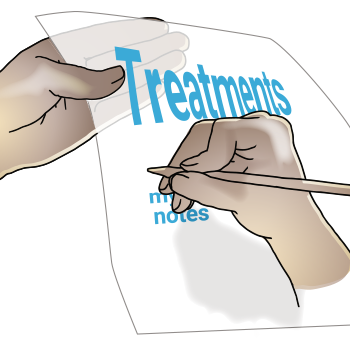
Keep your notes going as you proceed with these treatments


Keep your notes going as you proceed with these treatments
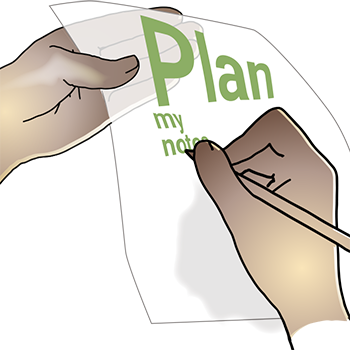
Keep your Plan notes updated, once treatments are given!

Keep your Plan notes updated, once treatments are given!
The RPE Scale (Rate of Perceived Exertion) is the means for a physio to measure how active their patient is during monitored exercise, results being recorded. A common means of recording the RPE Scale is the 60 second BORG test
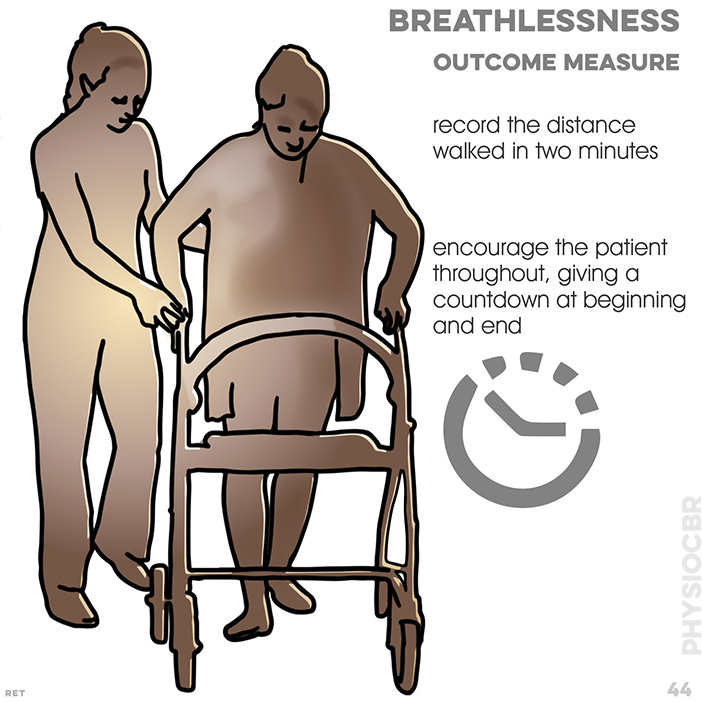
(anything other than complete rest))
(feels like you can maintain for hours, easy to breathe and carry on a conversation)
(feels like you can exercise for long periods of time, able to talk and hold short conversations)
(on the verge of becoming uncomfortable, short of breath, can speak a sentence)
(difficult to maintain exercise intensity, hard to speakmore than a single word)
(feels impossible to continue, completely out of breath, unable to talk)
As we gain evidence in Long Covid Treatment, we will add to this page


Keep your Plan notes updated, once treatments are given!

Keep your Plan notes updated, once treatments are given!
A three-stage process
Calmness is key: Relaxed breathing engages the vital process of diffusion, which is the process of gas exchange that takes place within the alveoli. It is this that causes the critical two-way transfer of oxygen and carbon dioxide, essential to the blood.
Also called 'thoracic expansion': Deep breathing includes holding the breath for a second or two (where possible) to encourage diffusion. After deep breathing, a few more relaxed breaths are recommended before continuing to the third 'huff' stage.
The critical stage: The huff is the point when the sputum is released, however if release is only partially successful, simply relax and repeat the three steps.. it is a process and not a test!
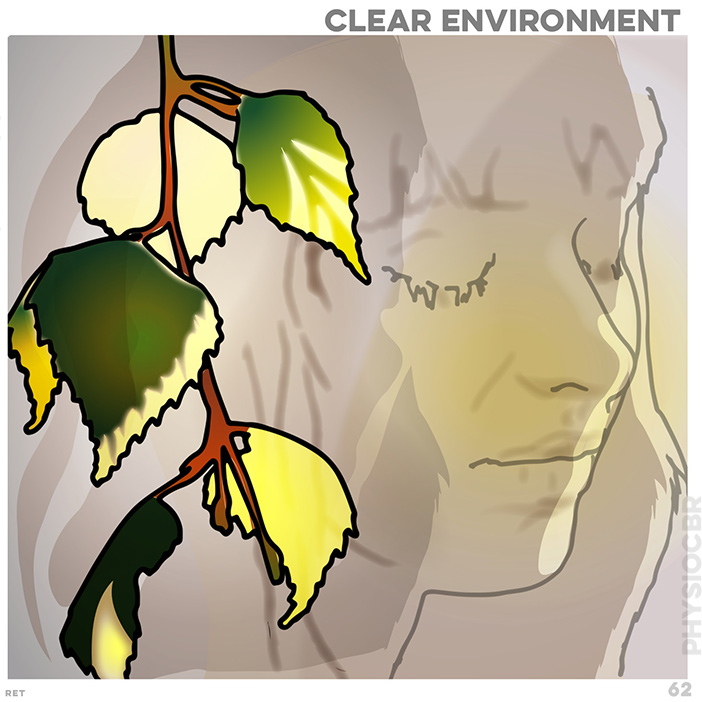
A calm relaxed environment is very important and the physio should also be relaxed...(62)

Education
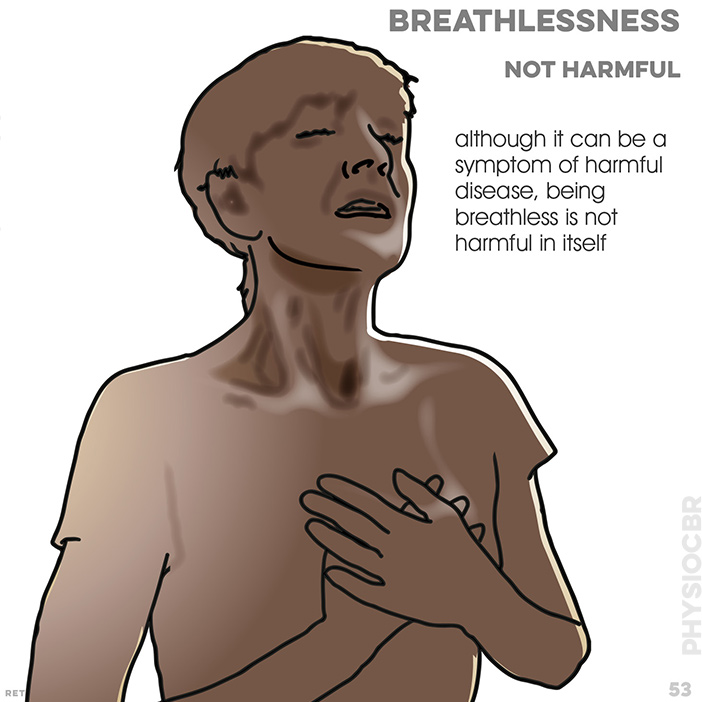
although it can be a symptom of harmful disease, breathlessness is not harmful in itself (53)
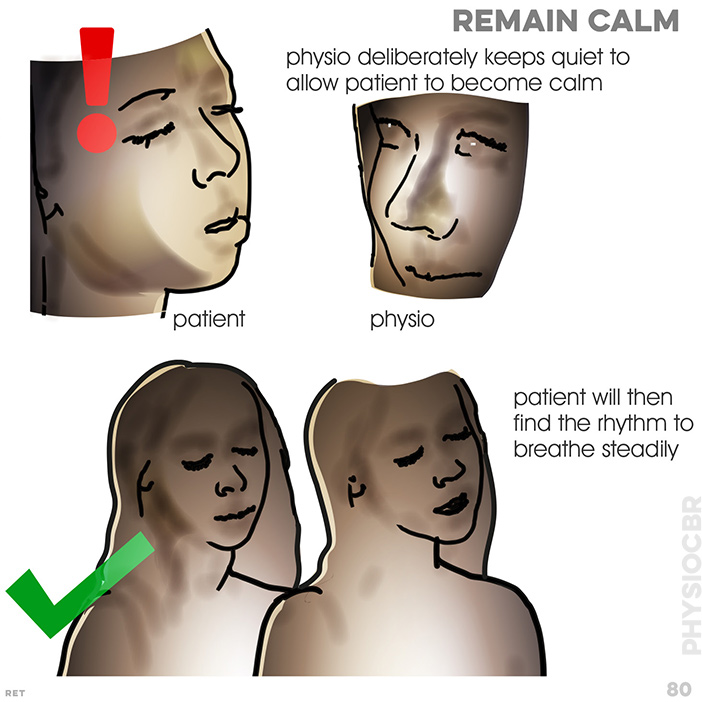
the physio should not direct the patient's breathing control but wait until a relaxed rhythm is found by the patient (80)
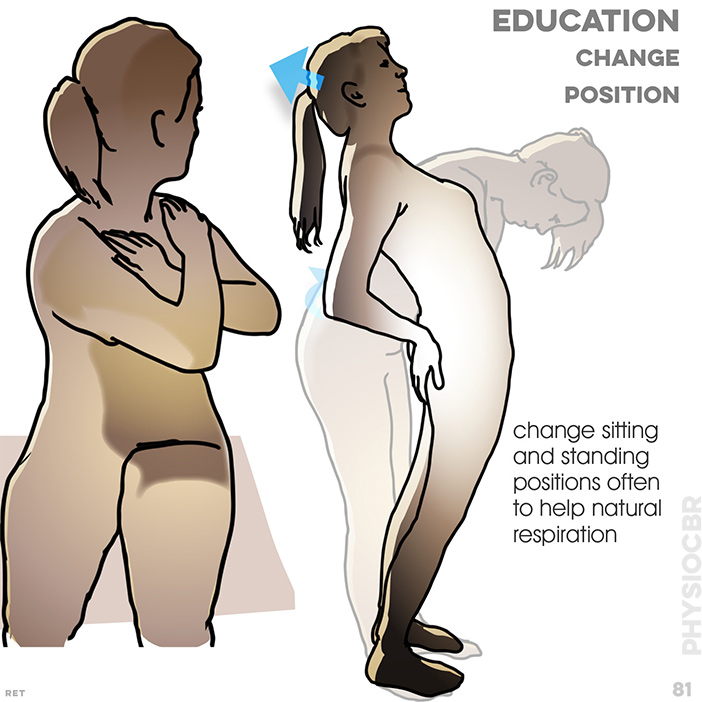
change position from sitting to standing to help natural respiration (81)
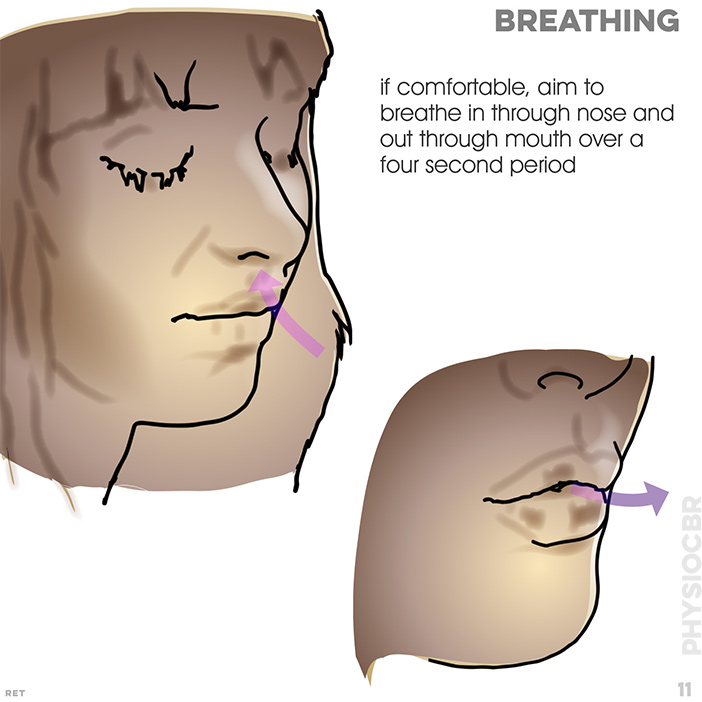
Breathing in through nose for 2 seconds and out through mouth for 4 seconds (11)
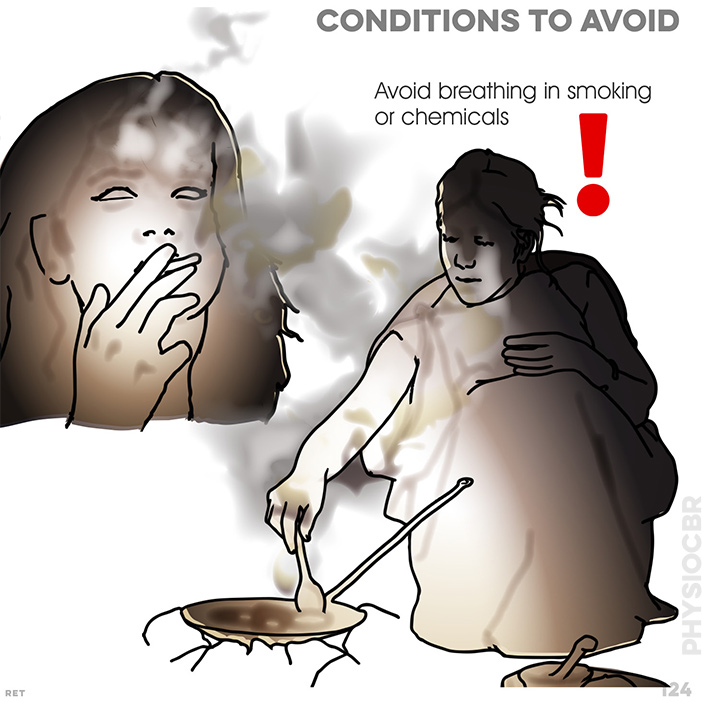
Conditions to avoid: avoid breathing in smoking or chemicals (124)

Desensitisation
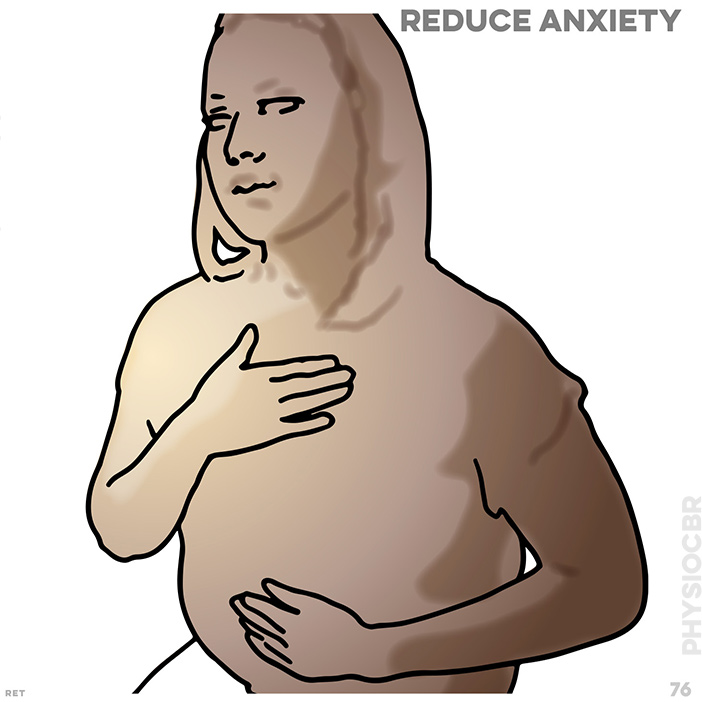
use abdominal breathing position to reduce anxiety (see below) (76)

desensitise respiratory anxiety by using mindful or stillness techniques (82)

Positioning

stabilise accessory muscles, such as shoulders, to support breathing (85)
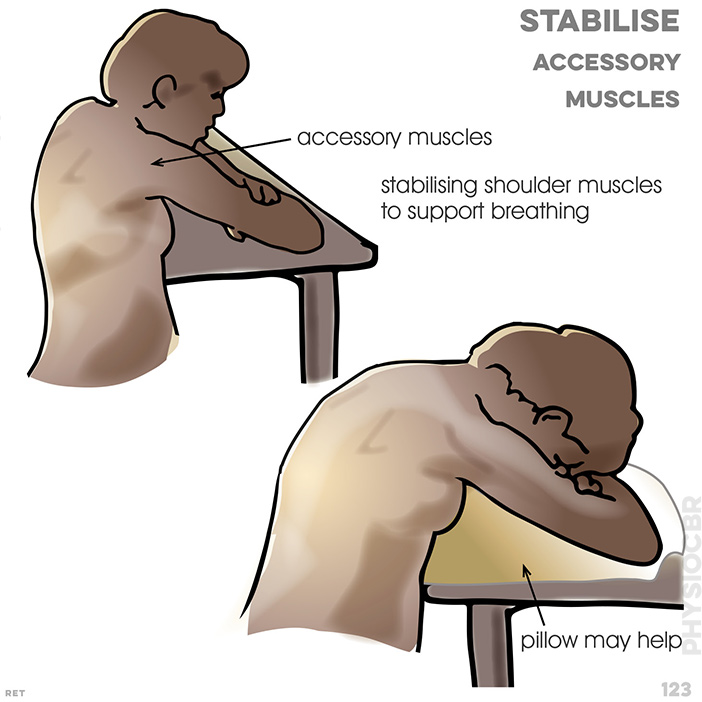
stabilise accessory muscles: stabilising shoulder muscles to support breathing (pillow may help) (123)
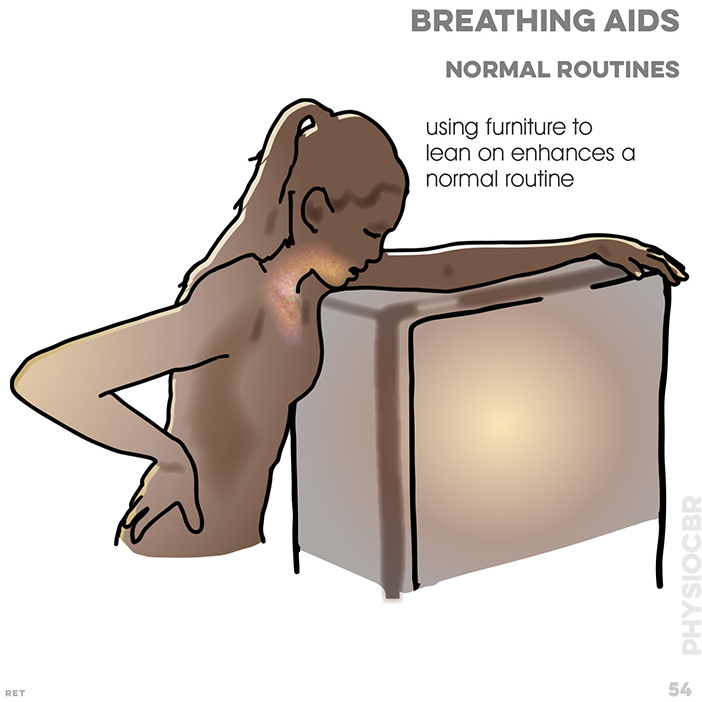
using furniture to lean on enhances a normal routine (54)

using a table with elbows on pillow to dome the diaphragm in a relaxed position (56)
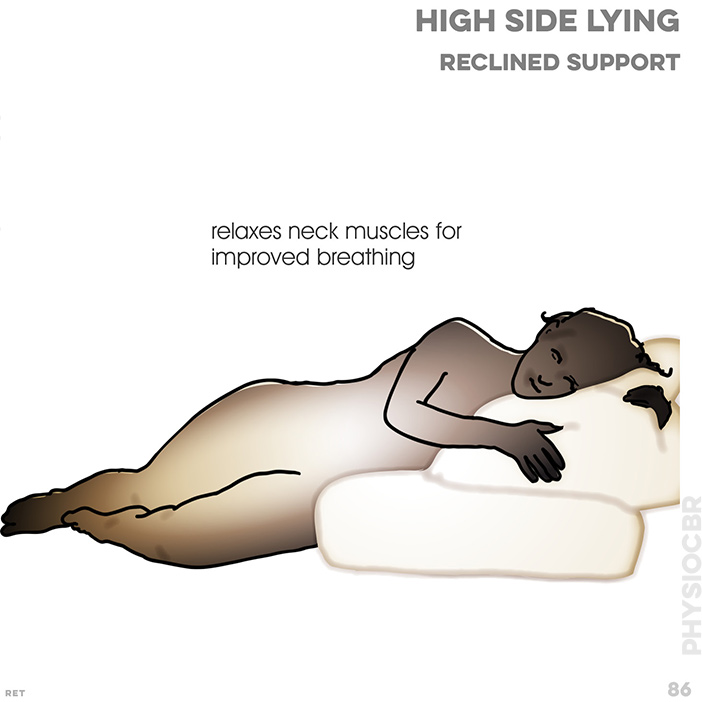
high side lying relaxes neck muscles for improved breathing (86)

Fan
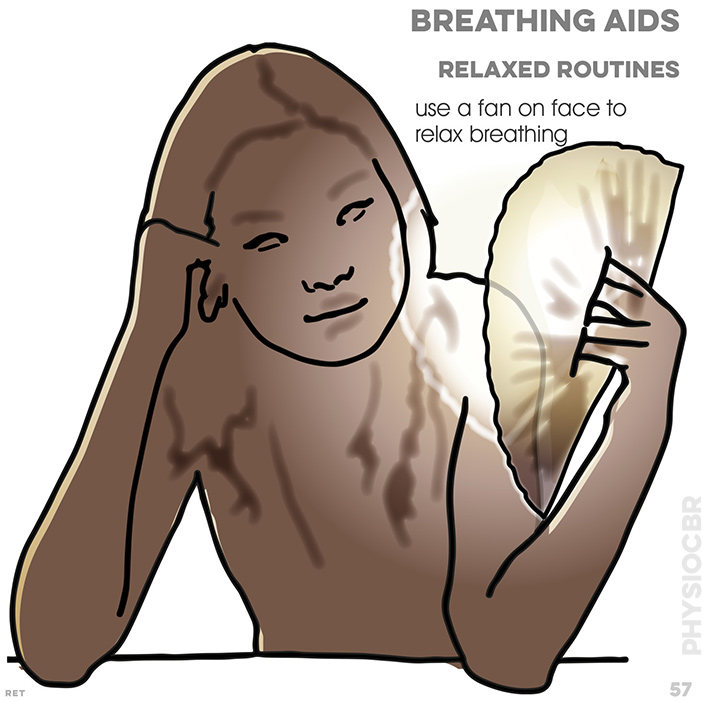
use a fan on face to relax breathing (57)
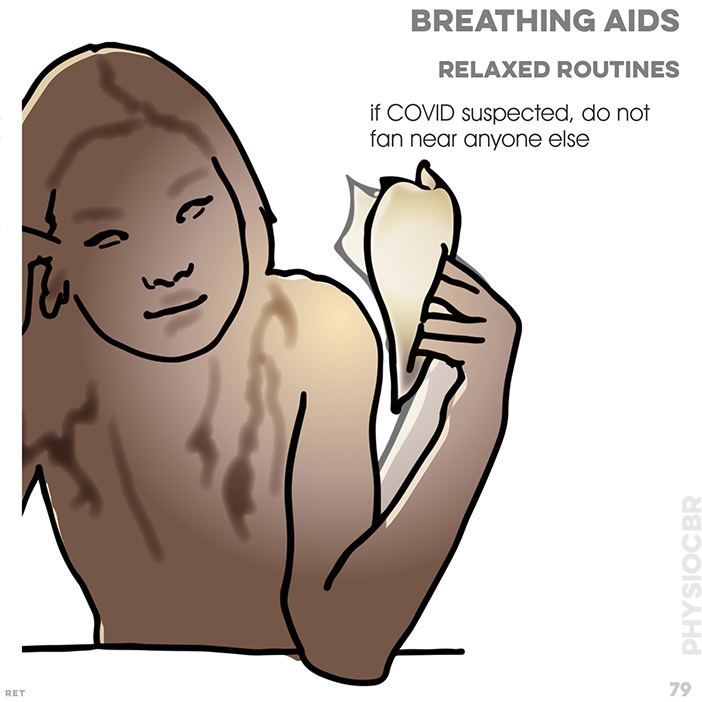
if COVID suspected, do not fan near anyone else (79)

Breathing techniques
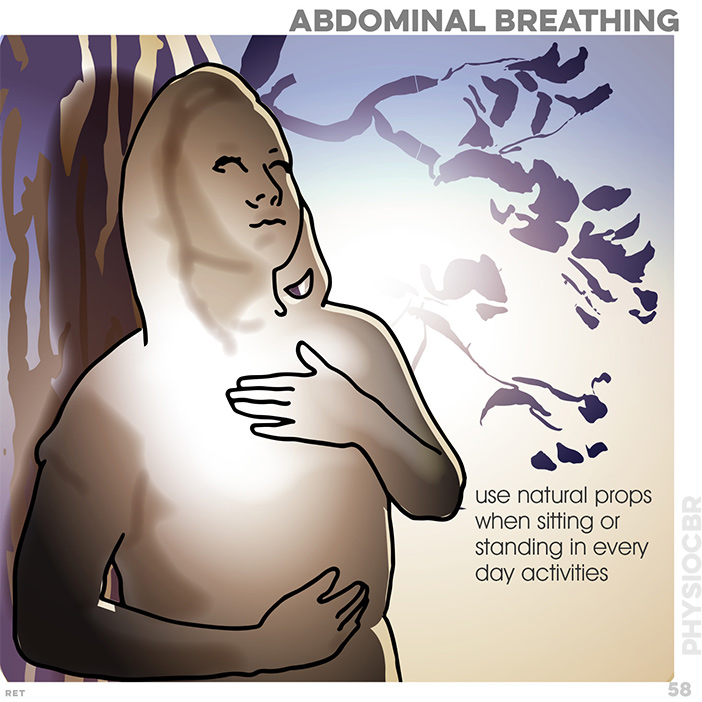
abdominal breathing can use natural props when sitting or standing in every day activities (58)
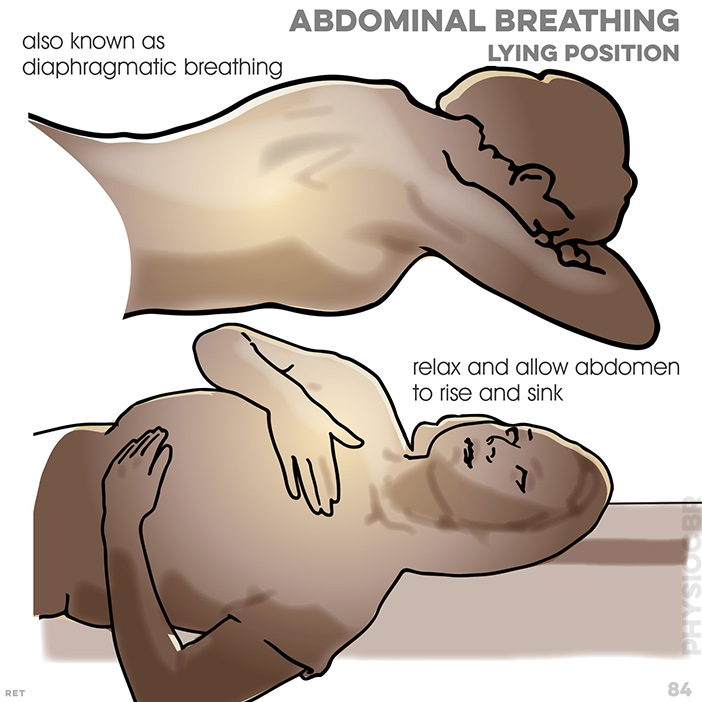
abdominal breathing (also known as diaphragmatic breathing) in a lying position, lets the abdomen rise and sink (84)
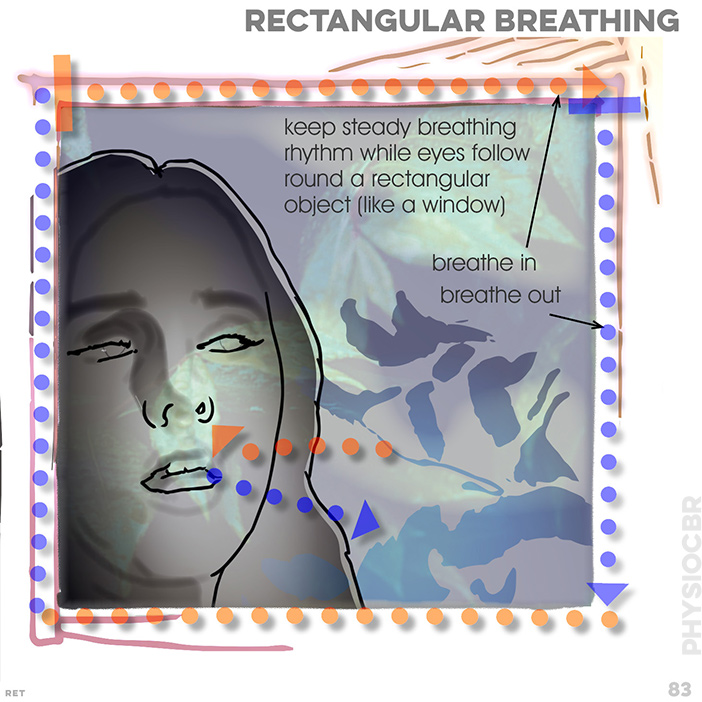
rectangular breathing keeps a steady rhythm by letting the eye follow round a rectangular object (such as a window) (83)

Accessory muscles: use upright, such as a tree, to lean against, allowing shoulders to aid lung movement (120)

Breathlessness aid, inhalant support: if too breathless to use regular inhaler, make an air-tight spacer from a plastic bottle and breath medication in slowly (128)

Fatigue management
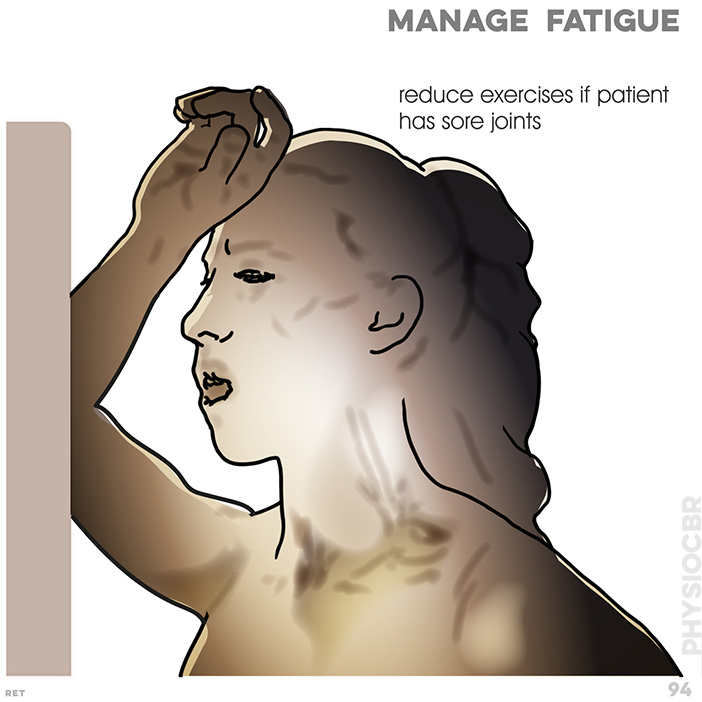
reduce exercises if patient has sore joints (94)
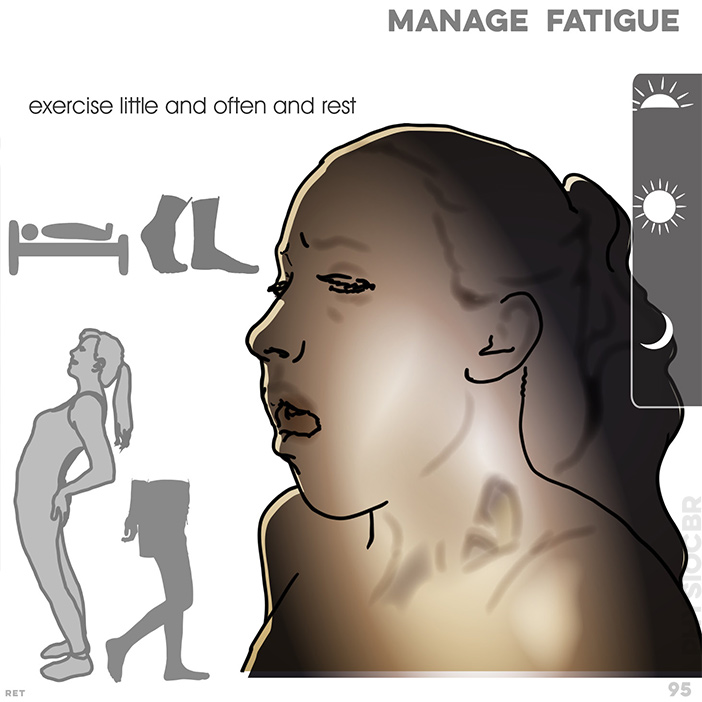
exercise little and often and rest (95)
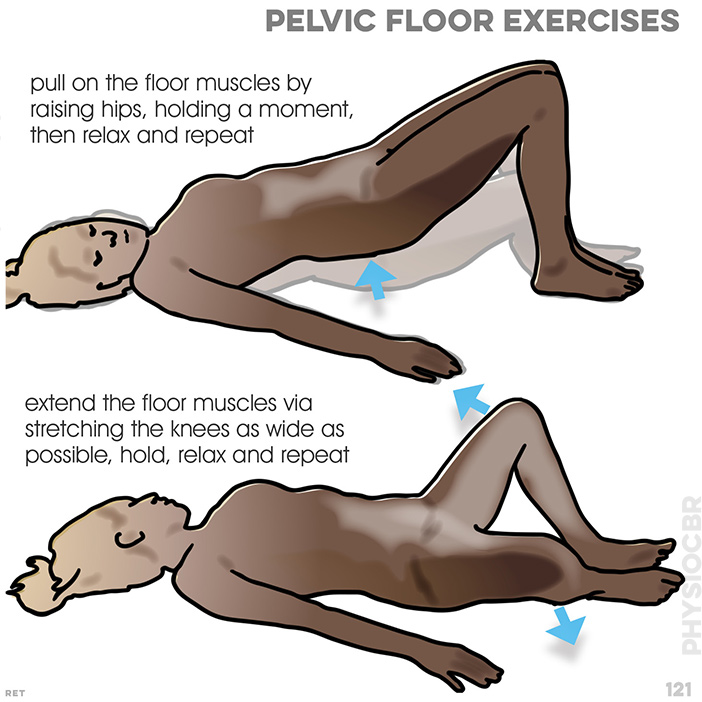
Pelvic floor exercises: lying on floor, raise hips, hold a moment and relax, then spread knees as wide as possible, hold, relax and repeat (121)

always clear sputum to avoid infection, using the following routines to help (23)

Education
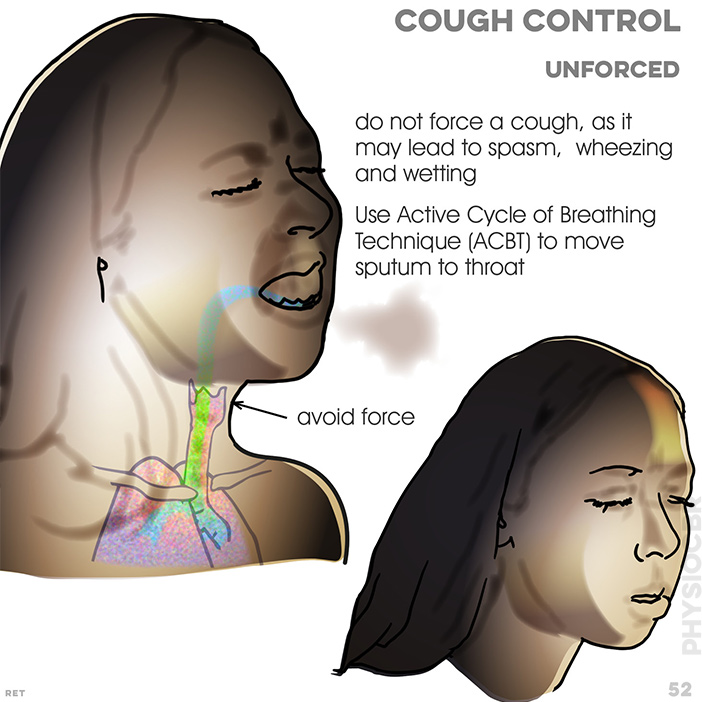
Coughing. Do not force a cough as it may lead to spasm, wheezing and wetting (52)

Dry cough control: use warm water with honey and lemon, or grate ginger into hot water; inhale, drink and apply breathing control (129)
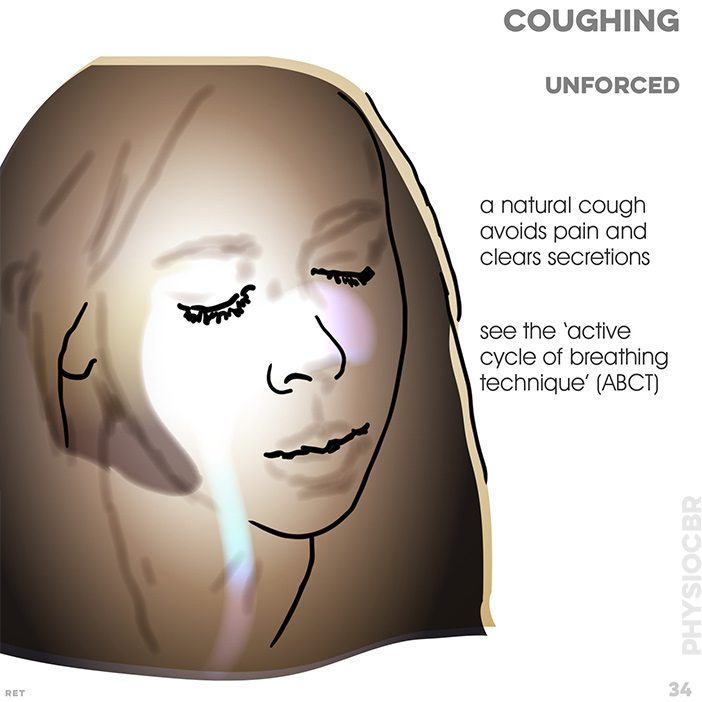
A natural cough avoids pain and clears secretions. see 'active cycle of breathing' (ABCT) (34)
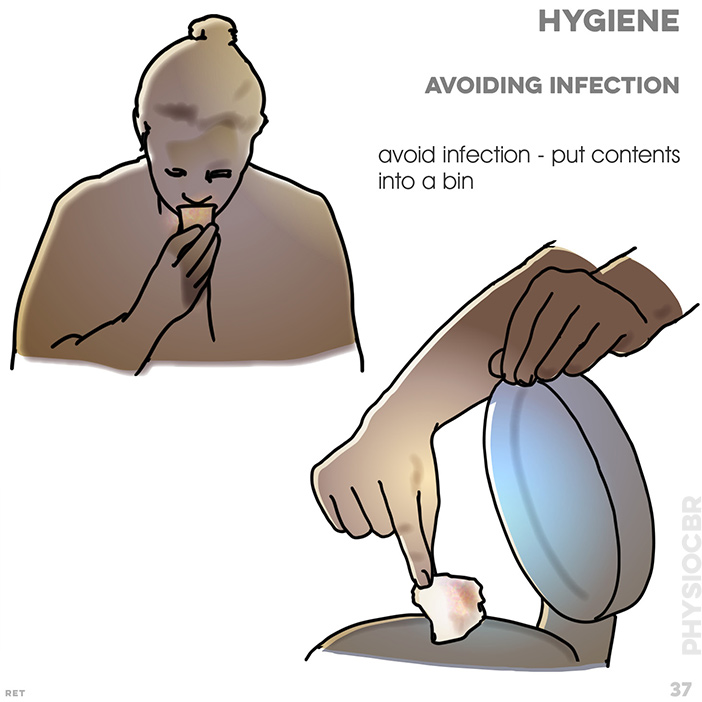
avoid infection - put contents into a bin (37)
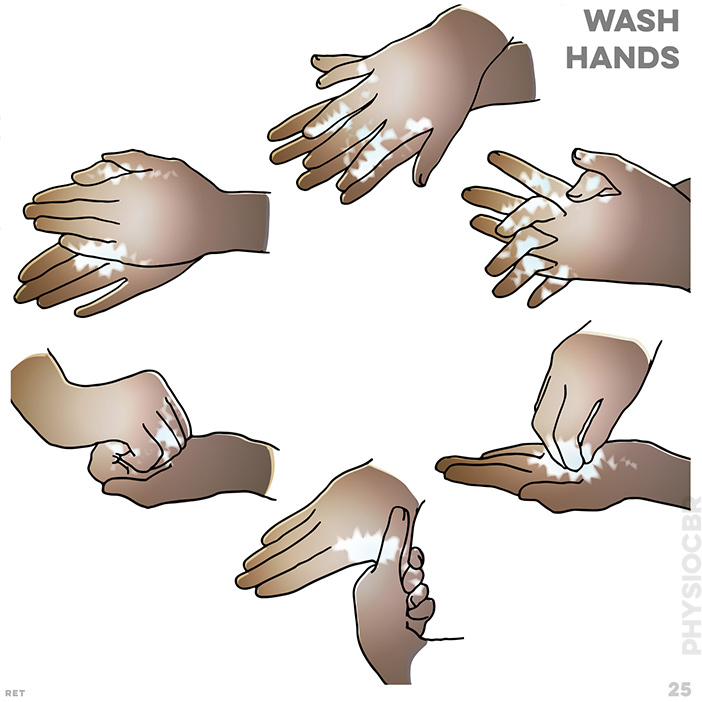
Wash hands using all six positions shown (25)

washing hands (26)

Conditions to avoid: avoid breathing in smoking or chemicals (124)

Hydration
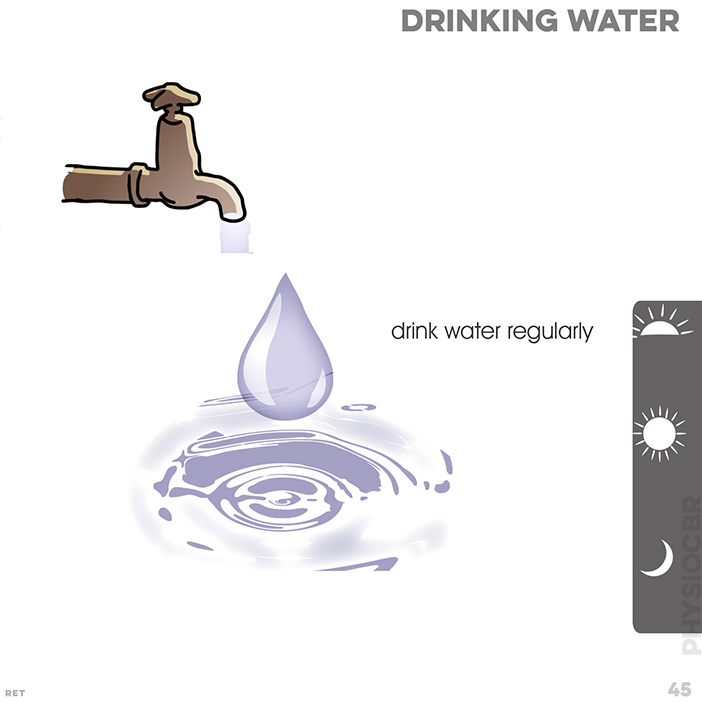
Be sure to drink water as this is key to all respiratory issues (45)
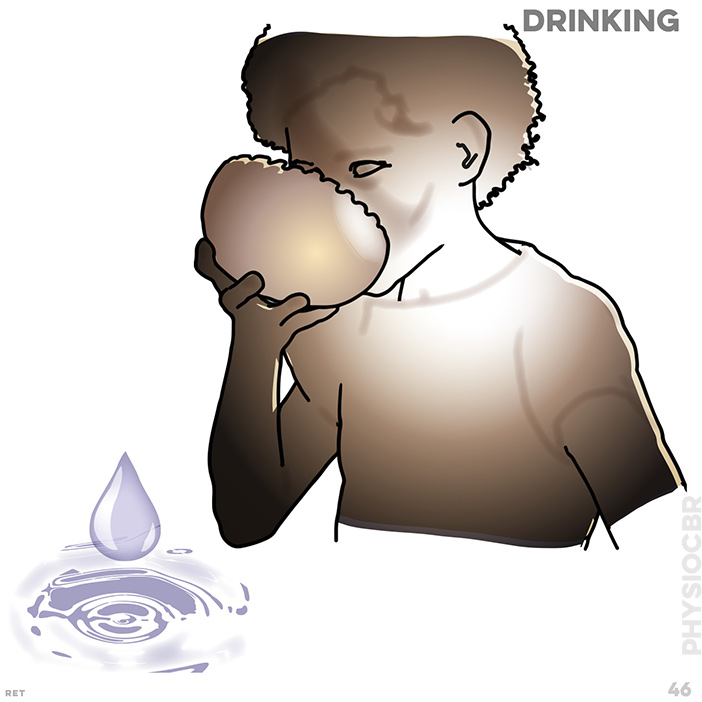
drink water regularly (46)

Humidification
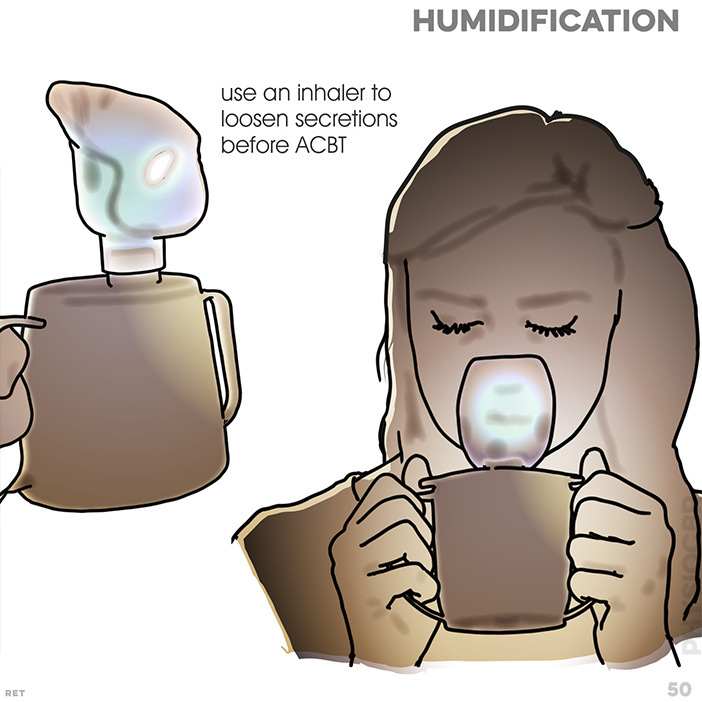
Humidification. use an inhaler to loosen secretions before the breathing cycle (ACBT) (50)
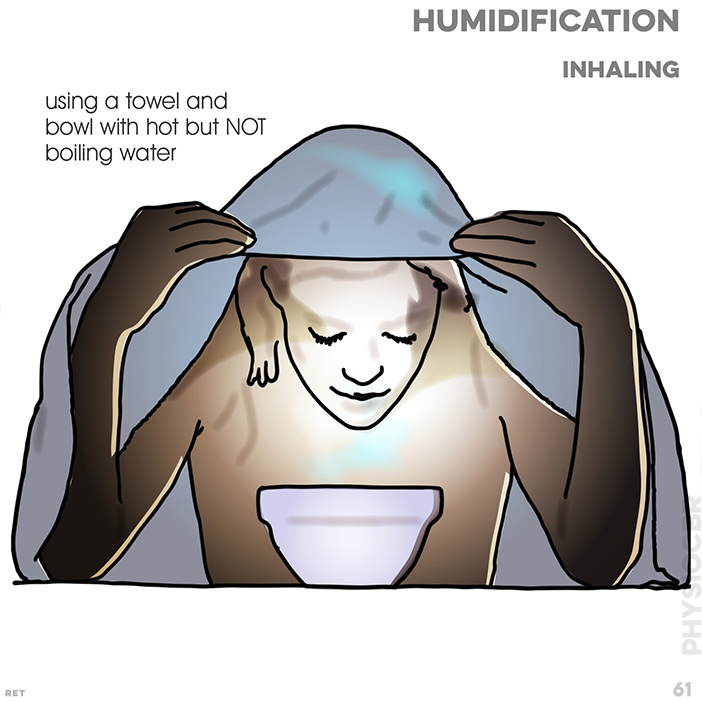
Humidification and inhaling. Using a towel and bowl with hot but NOT boiling water (61)

Postural drainage
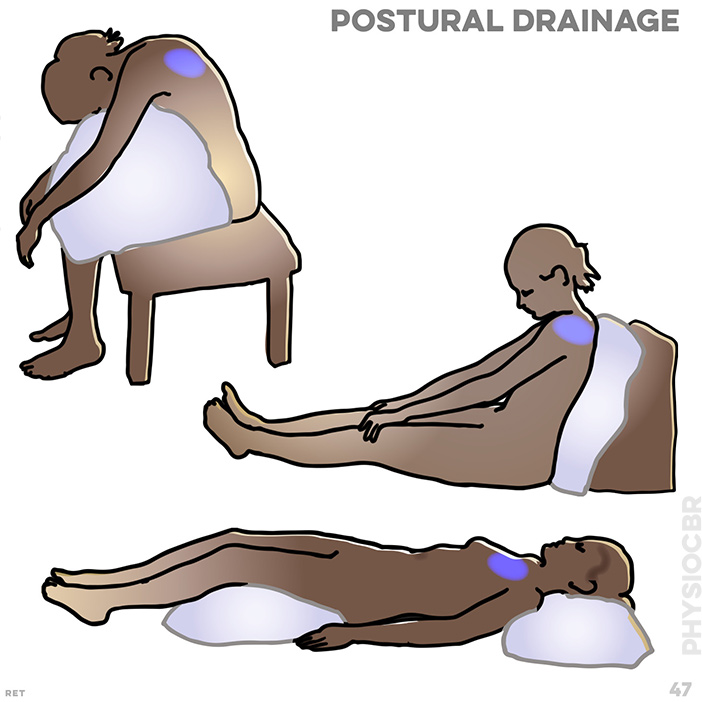
Postural drainage positions for relevant sections of lungs (47)

Postural drainage positions for relevant sections of lungs (48)
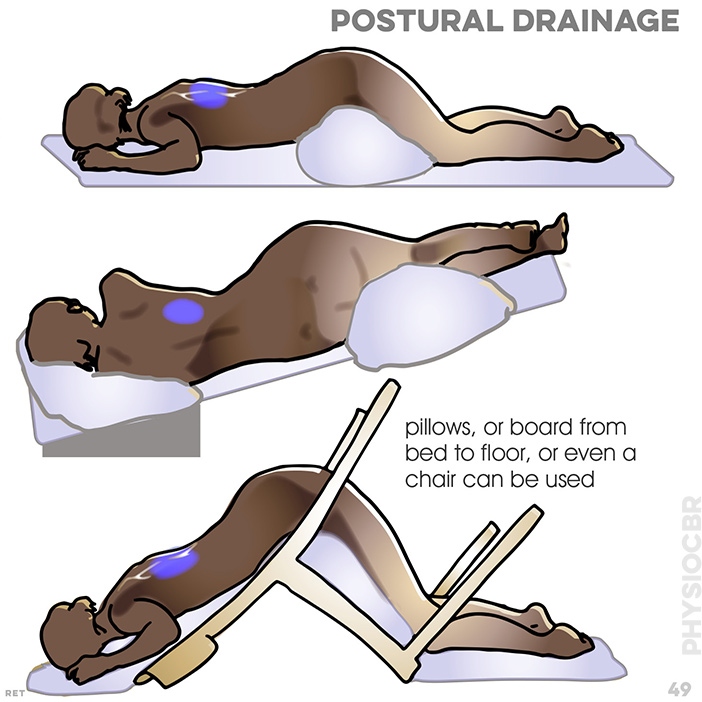
Postural drainage positions for relevant sections of lungs (49)

Percussion
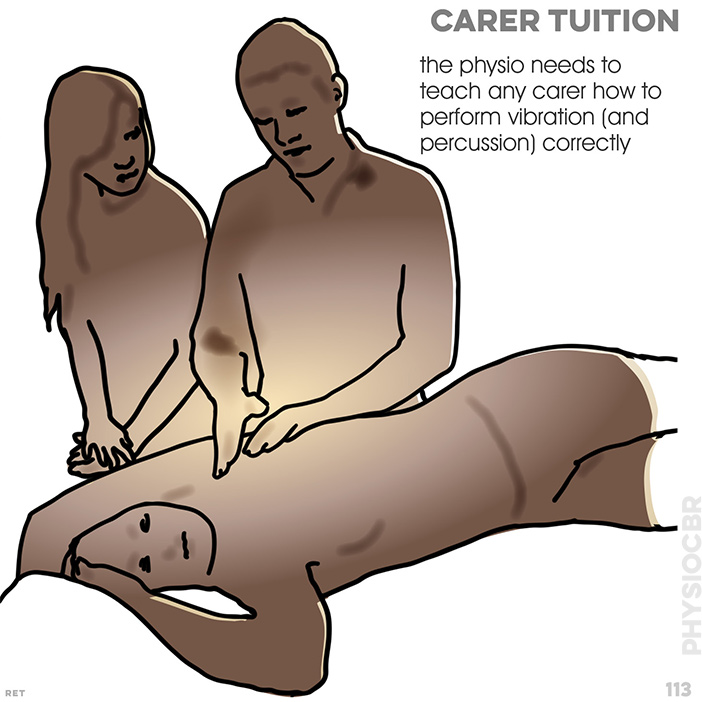
carer tuition: the physio needs to teach any carer how to perform vibration (and percussion) correctly (113)
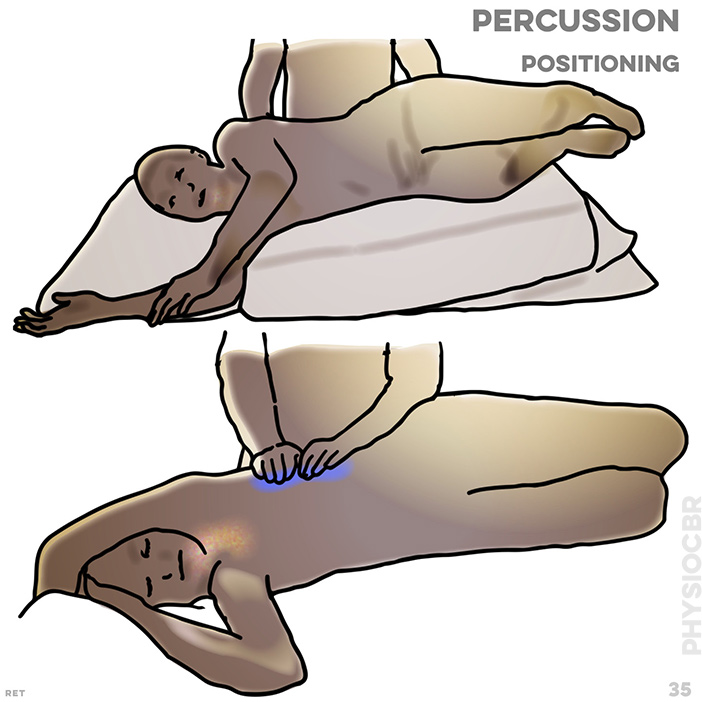
Positioning for percussion (35)
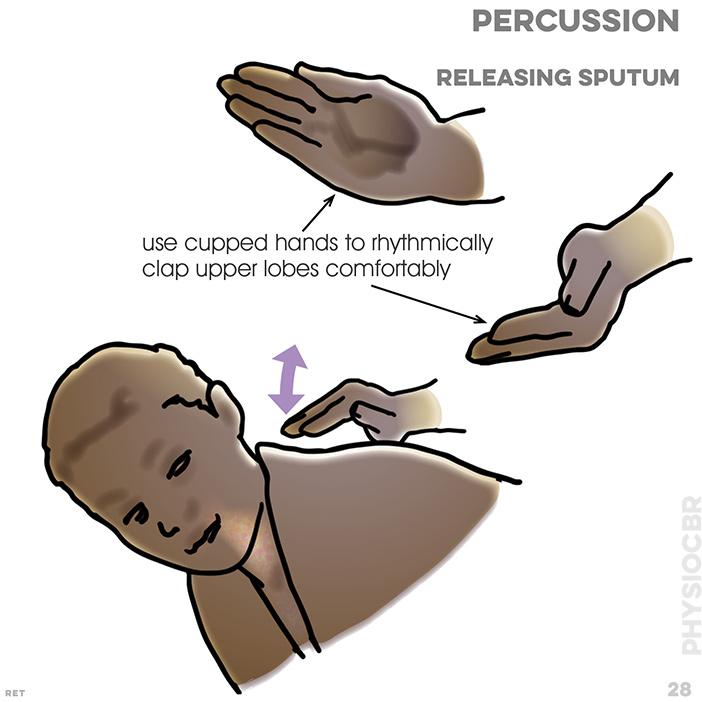
releasing sputum through rhythmical percussion, using cupped hands (28)

releasing sputum in side-lying position (32)
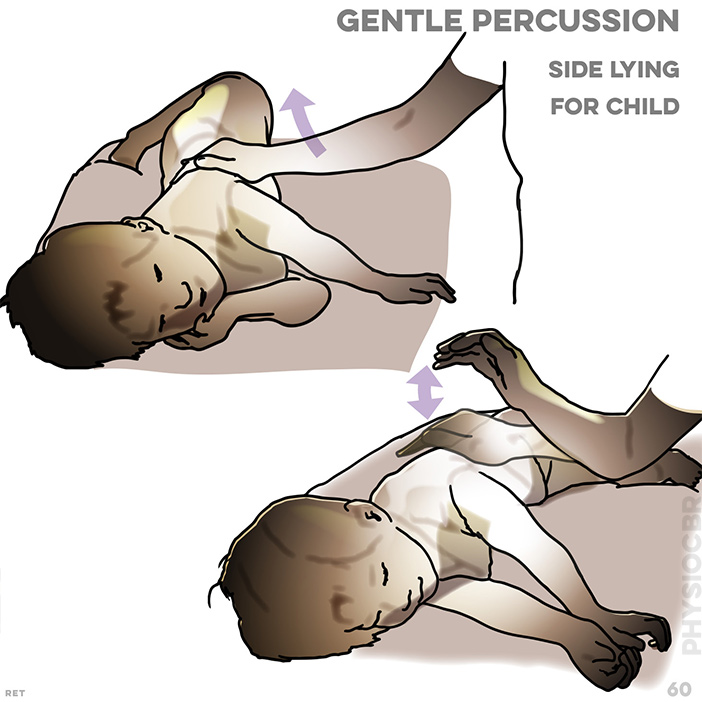
Percussion on side-lying child (60)
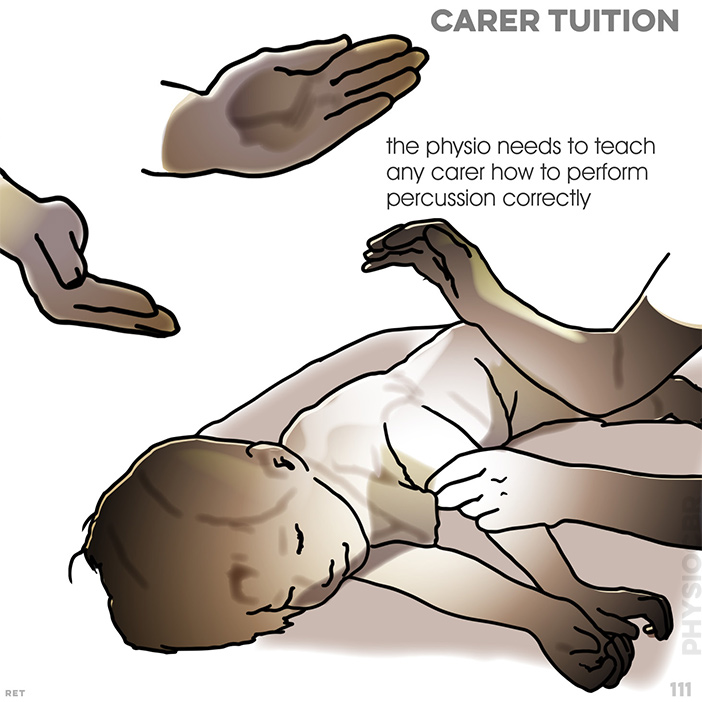
the physio needs to teach any carer how to perform percussion correctly (111)

Vibration

carer tuition: the physio needs to teach any carer how to perform vibration (and percussion) correctly (113)
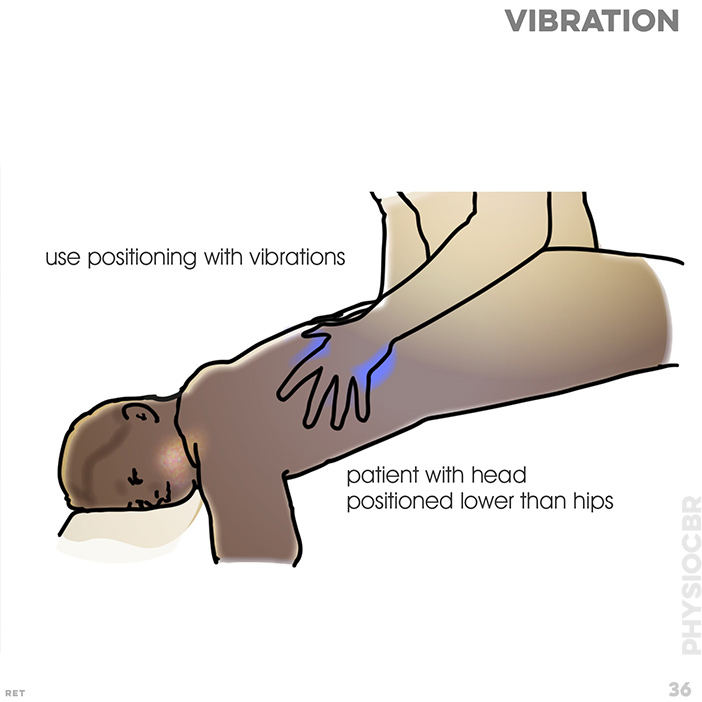
using positioning with vibrations and position with head lower than hips (36)

Release sputum. patient breathes in as fully as possible, then physio vibrates hands whilst patient exhales (33)

Using a PEP tube to breathe out into water actively but not forcefully, creating bubbles and expanding airways (39)

Active cycle of breathing technique
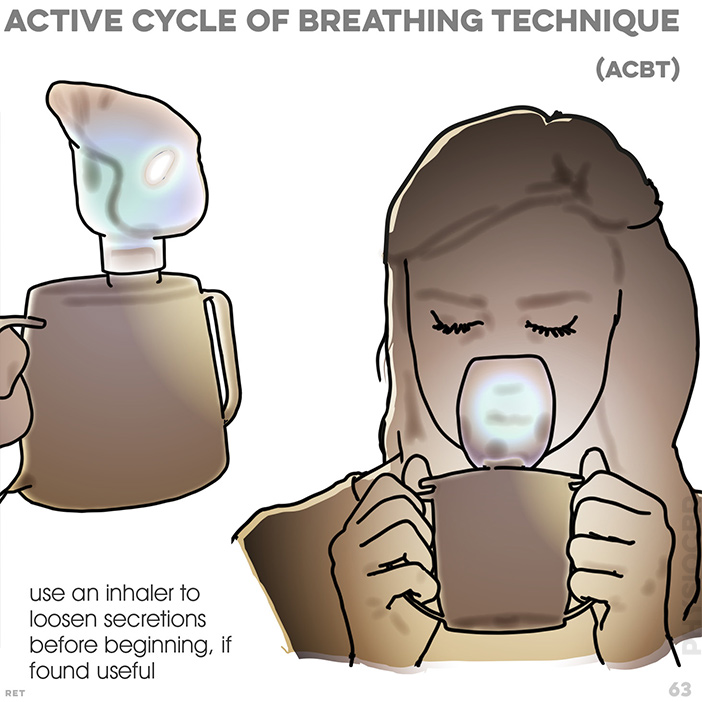
Active cycle of breathing can start with using an inhaler to loosen secretions (63)
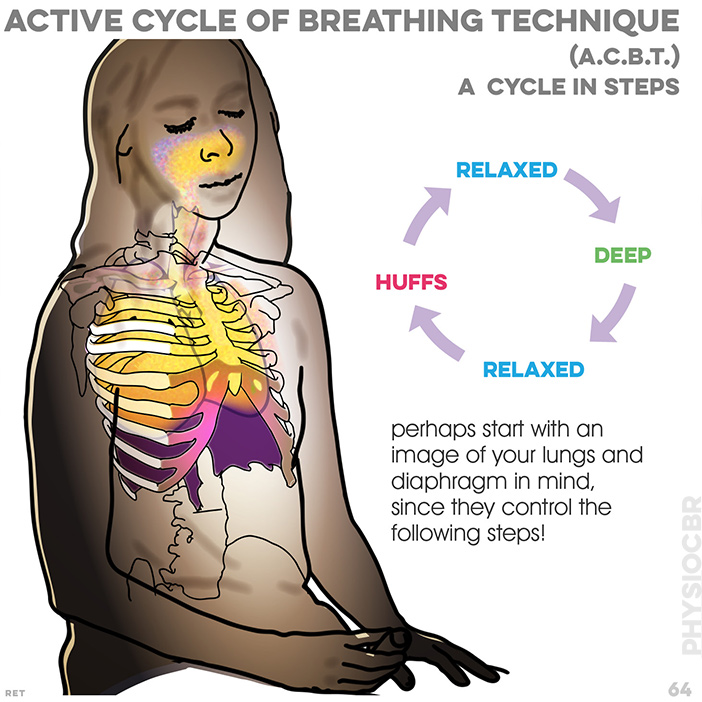
A cycle in steps. relaxed. deep breath, relaxed, huff. Start with an image of your lungs and diaphragm in mind, since they control the following steps! (64)

relaxed breathing, step 1. breathe comfortably in through nose to humidify air going to lungs (65)
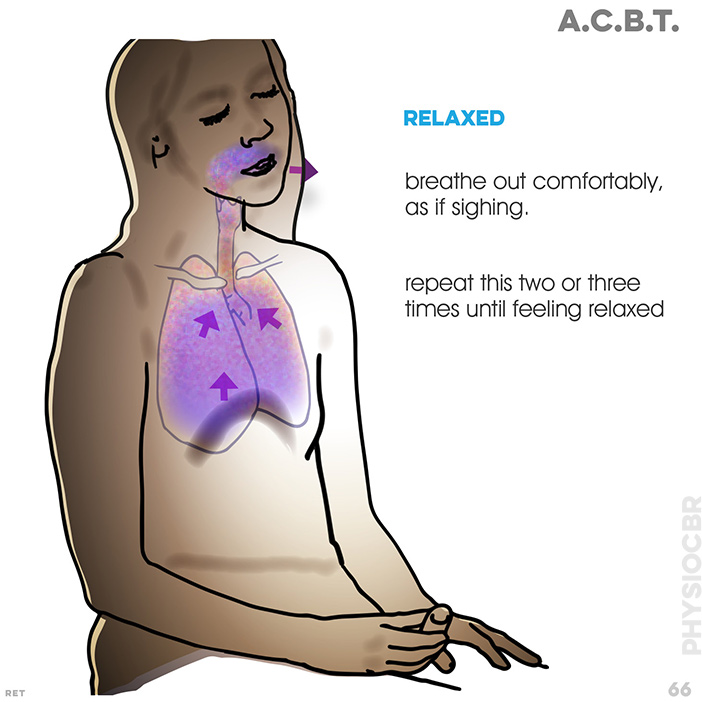
relaxed breathing, step 2. breathe out comfortably as if sighing. repeat relaxed breathing two or three times (66)
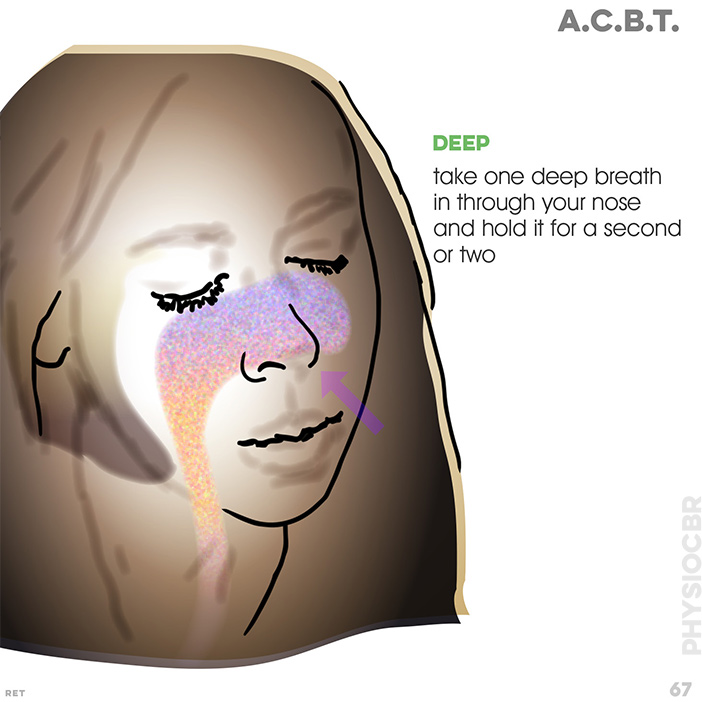
deep breathing, step 1. take one deep breath in through your nose and hold it for a second (67)
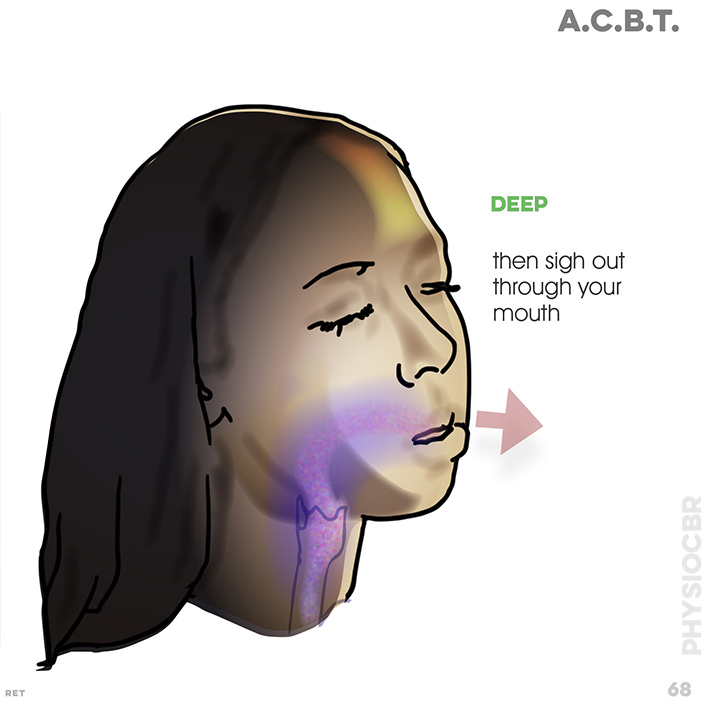
deep breathing, step 2. then sigh out through your mouth (68)
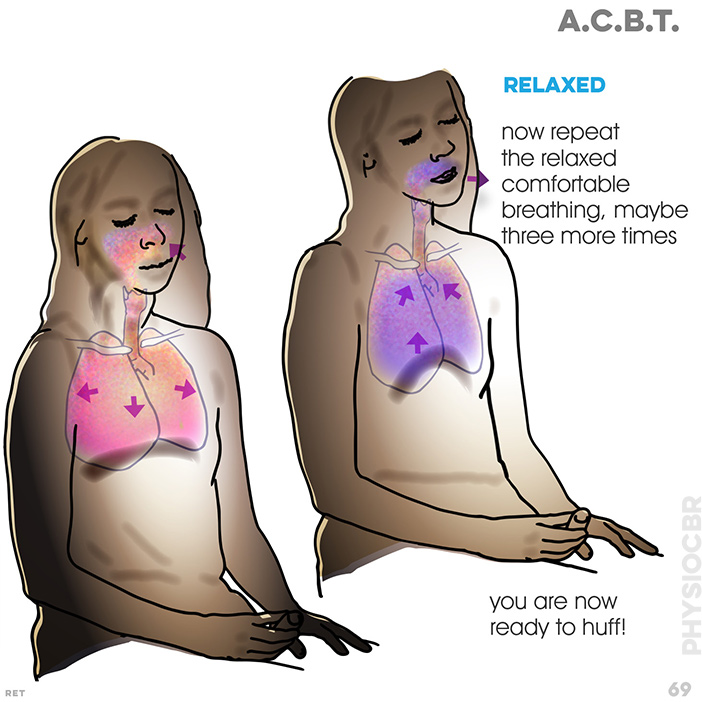
relaxed breathing, step 3. now repeat the relaxed breathing, maybe three more times. you are now ready to huff! (69)

huff, step 1. sputum cannot be felt when deep in lungs, so start with a small breath in (70)
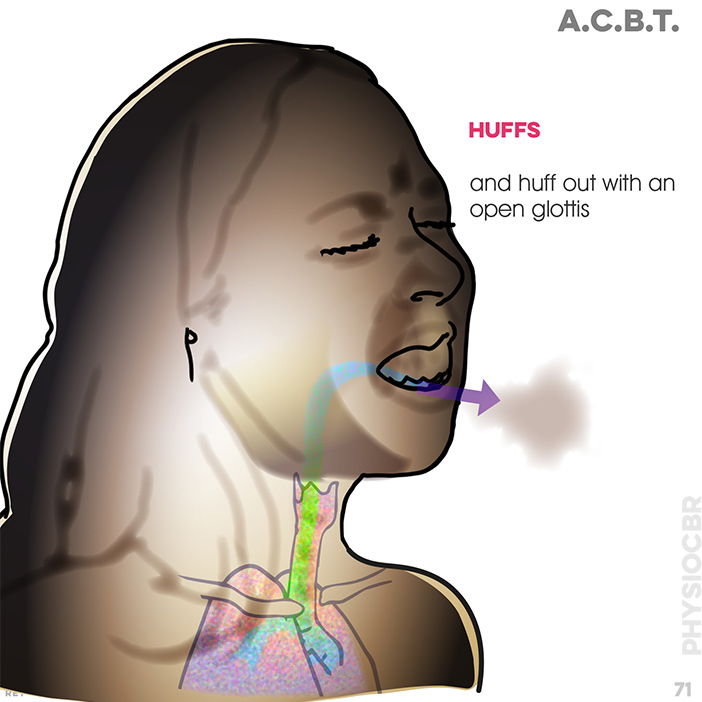
huff, step 2. and huff out with an open glottis. sputum will shift upward (71)
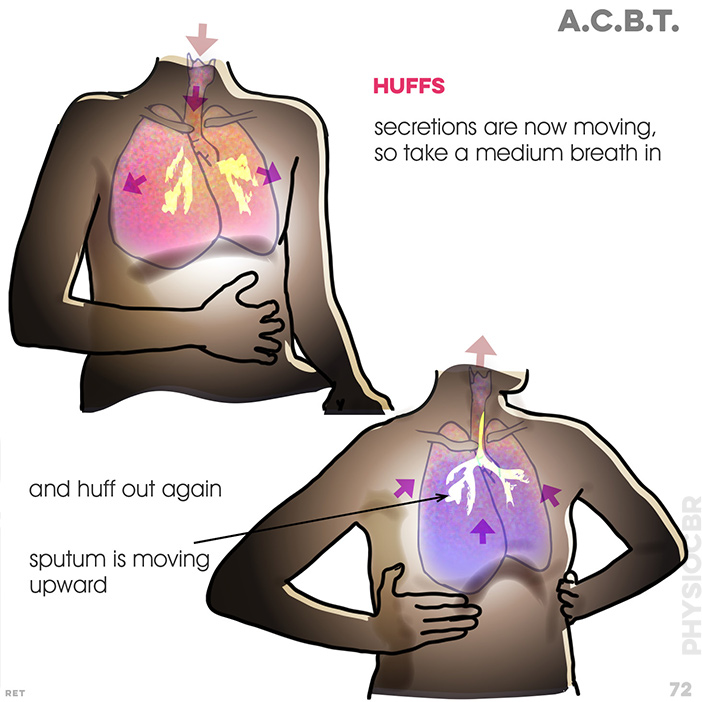
huff, step 3. secretions are now moving, so take a medium breath in and huff out again (72)
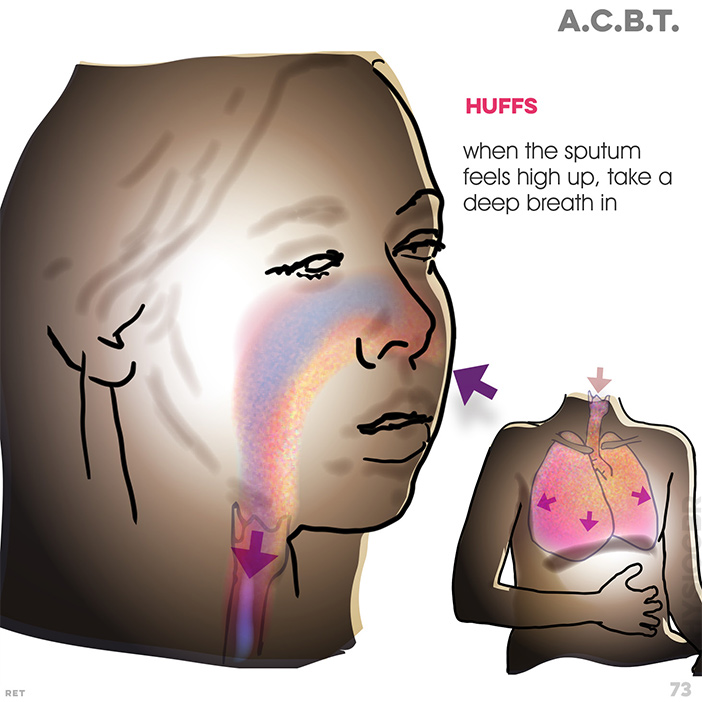
huff, step 4. when the sputum feels high up at the top of the lungs, take a deep breath in (73)
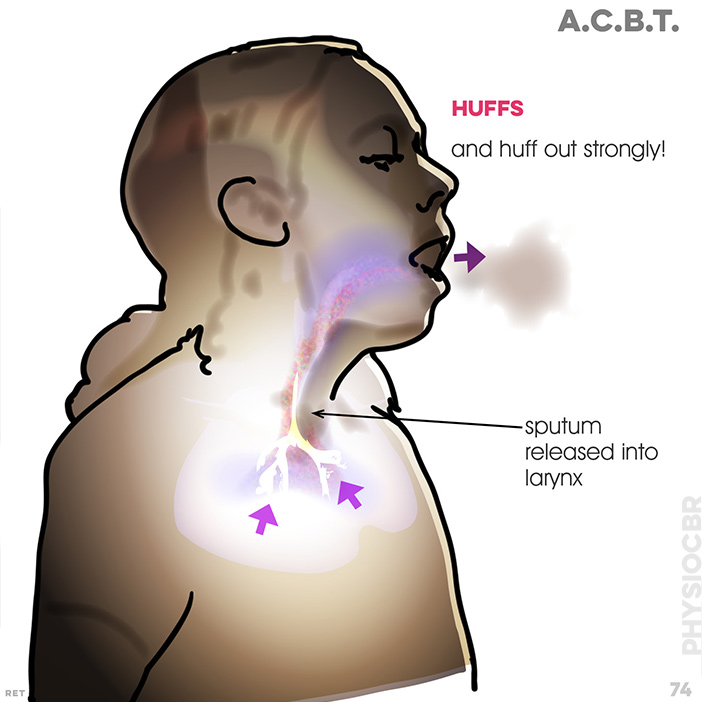
huff, step 5. and huff out strongly! (sputum now in larynx) (74)

sputum can now be coughed out (75)
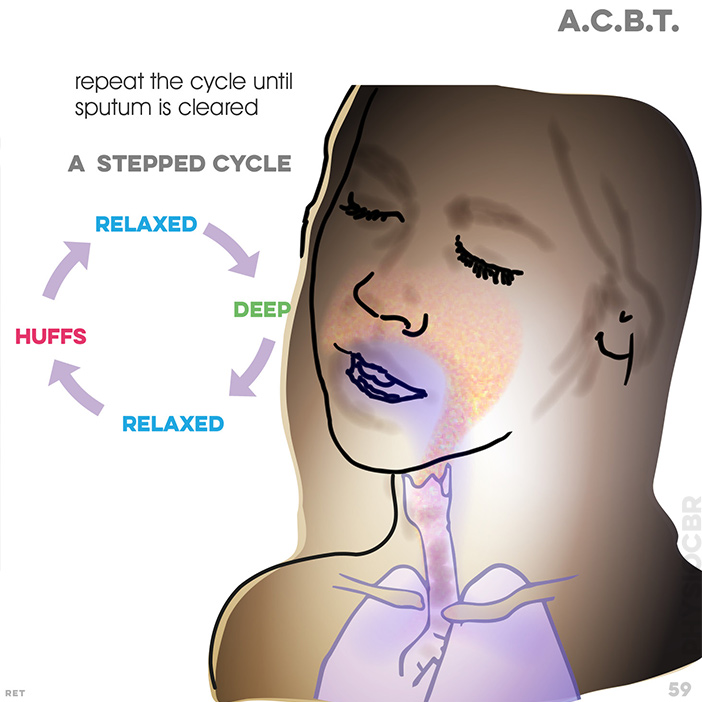
Repeat the full cycle if incompleteness is felt: relaxed breathing, deep breath, relaxed, huffs... (59)

Cough
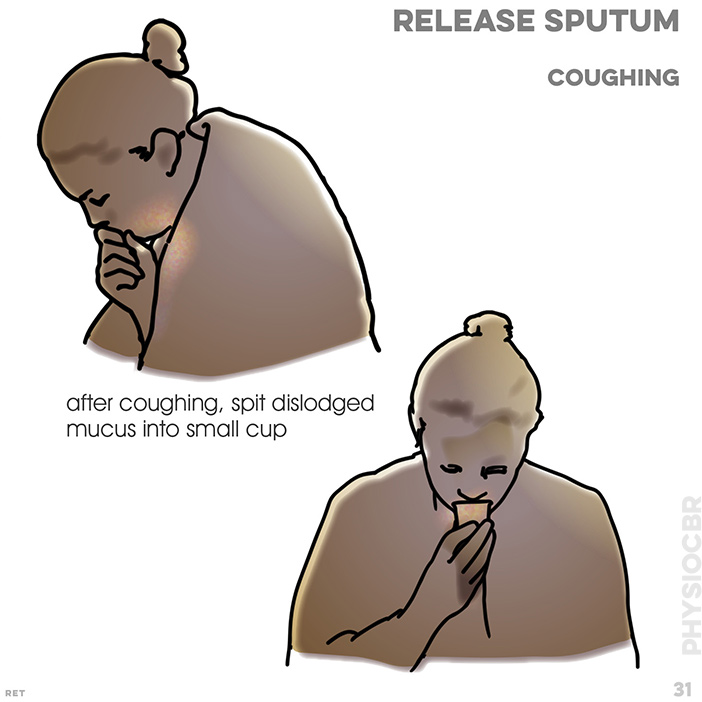
after coughing, spit dislodged mucus into small cup (31)
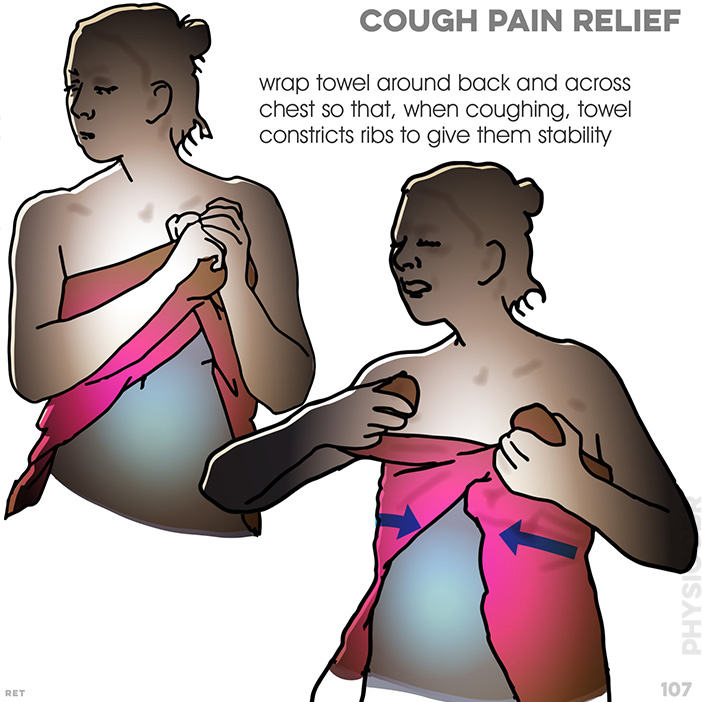
cough pain relief: a towel is wrapped around back and crossed at chest and when coughing, pull the ends further apart (107)

Massage for aches: massage of most shoulder (accessory) muscles greatly helps lung control (126)

for post COVID exercise, listen to the patient in order to maintain a manageable pace (116)

A calm relaxed environment is very important and the physio should also be relaxed... (62

De-sensitisation

use abdominal breathing position to reduce anxiety (see below) (76)

desensitise respiratory anxiety by using mindful or stillness techniques (82)
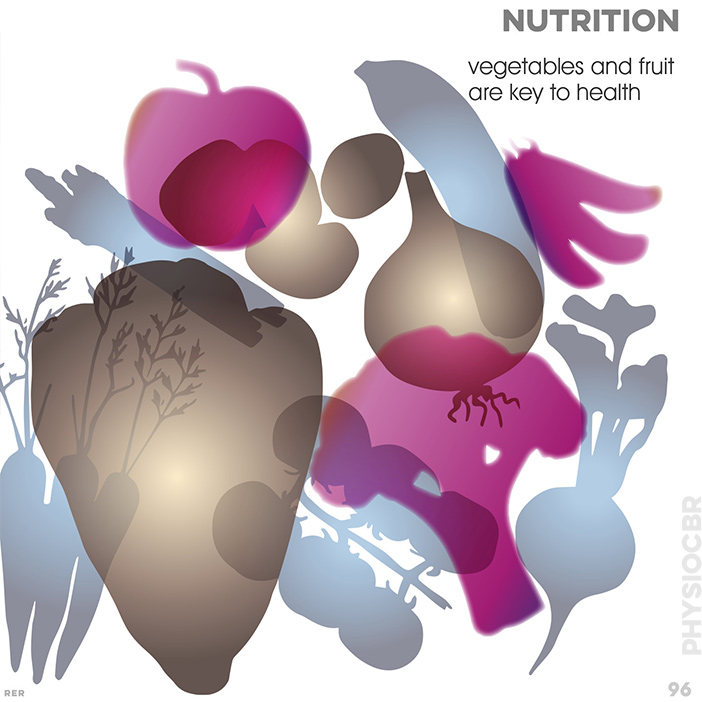
for nutrition, eating vegetables is key to health (96)
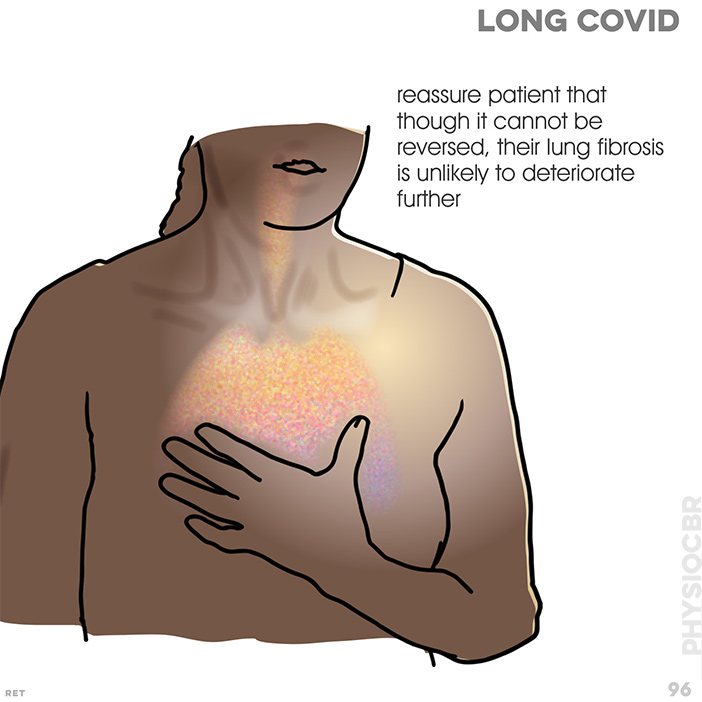
reassure patient that though it cannot be reversed, their lung fibrosis is unlikely to deteriorate further (96)

Positioning

stabilise accessory muscles, such as shoulders, to support breathing (85)

using furniture to lean on enhances a normal routine (54)

using a table with elbows on pillow to dome the diaphragm in a relaxed position (56)

high side lying relaxes neck muscles for improved breathing (86)

Fan

use a fan on face to relax breathing (57)

if COVID suspected, do not fan near anyone else (79)

Breathing techniques

abdominal breathing can use natural props when sitting or standing in every day activities (58)

abdominal breathing (also known as diaphragmatic breathing) in a lying position, lets the abdomen rise and sink (84)

rectangular breathing keeps a steady rhythm by letting the eye follow round a rectangular object (such as a window) (83)

Fatigue management

reduce exercises if patient has sore joints (94)

exercise little and often and rest (95)